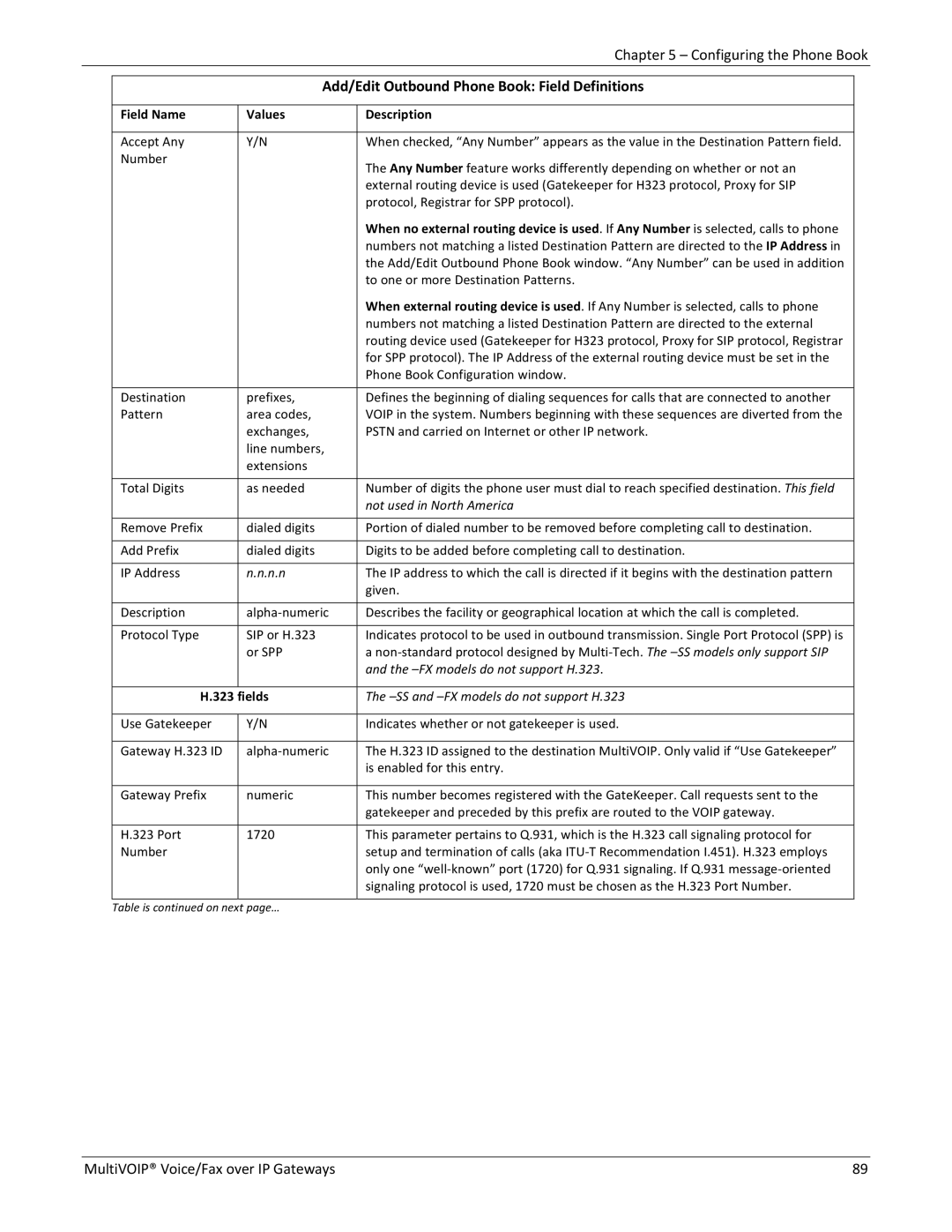|
|
| Chapter 5 – Configuring the Phone Book | |
|
|
|
|
|
|
| Add/Edit Outbound Phone Book: Field Definitions |
| |
|
|
|
|
|
| Field Name | Values | Description |
|
|
|
|
|
|
| Accept Any | Y/N | When checked, “Any Number” appears as the value in the Destination Pattern field. |
|
| Number |
| The Any Number feature works differently depending on whether or not an |
|
|
|
|
| |
|
|
| external routing device is used (Gatekeeper for H323 protocol, Proxy for SIP |
|
|
|
| protocol, Registrar for SPP protocol). |
|
|
|
| When no external routing device is used. If Any Number is selected, calls to phone |
|
|
|
| numbers not matching a listed Destination Pattern are directed to the IP Address in |
|
|
|
| the Add/Edit Outbound Phone Book window. “Any Number” can be used in addition |
|
|
|
| to one or more Destination Patterns. |
|
|
|
| When external routing device is used. If Any Number is selected, calls to phone |
|
|
|
| numbers not matching a listed Destination Pattern are directed to the external |
|
|
|
| routing device used (Gatekeeper for H323 protocol, Proxy for SIP protocol, Registrar |
|
|
|
| for SPP protocol). The IP Address of the external routing device must be set in the |
|
|
|
| Phone Book Configuration window. |
|
|
|
|
|
|
| Destination | prefixes, | Defines the beginning of dialing sequences for calls that are connected to another |
|
| Pattern | area codes, | VOIP in the system. Numbers beginning with these sequences are diverted from the |
|
|
| exchanges, | PSTN and carried on Internet or other IP network. |
|
|
| line numbers, |
|
|
|
| extensions |
|
|
|
|
|
|
|
| Total Digits | as needed | Number of digits the phone user must dial to reach specified destination. This field |
|
|
|
| not used in North America |
|
|
|
|
|
|
| Remove Prefix | dialed digits | Portion of dialed number to be removed before completing call to destination. |
|
|
|
|
|
|
| Add Prefix | dialed digits | Digits to be added before completing call to destination. |
|
|
|
|
|
|
| IP Address | n.n.n.n | The IP address to which the call is directed if it begins with the destination pattern |
|
|
|
| given. |
|
|
|
|
|
|
| Description | alpha‐numeric | Describes the facility or geographical location at which the call is completed. |
|
|
|
|
|
|
| Protocol Type | SIP or H.323 | Indicates protocol to be used in outbound transmission. Single Port Protocol (SPP) is |
|
|
| or SPP | a non‐standard protocol designed by Multi‐Tech. The |
|
|
|
| and the |
|
|
|
|
|
|
| H.323 fields | The |
| |
|
|
|
|
|
| Use Gatekeeper | Y/N | Indicates whether or not gatekeeper is used. |
|
|
|
|
|
|
| Gateway H.323 ID | alpha‐numeric | The H.323 ID assigned to the destination MultiVOIP. Only valid if “Use Gatekeeper” |
|
|
|
| is enabled for this entry. |
|
|
|
|
|
|
| Gateway Prefix | numeric | This number becomes registered with the GateKeeper. Call requests sent to the |
|
|
|
| gatekeeper and preceded by this prefix are routed to the VOIP gateway. |
|
|
|
|
|
|
| H.323 Port | 1720 | This parameter pertains to Q.931, which is the H.323 call signaling protocol for |
|
| Number |
| setup and termination of calls (aka ITU‐T Recommendation I.451). H.323 employs |
|
|
|
| only one “well‐known” port (1720) for Q.931 signaling. If Q.931 message‐oriented |
|
|
|
| signaling protocol is used, 1720 must be chosen as the H.323 Port Number. |
|
|
|
|
|
|
| Table is continued on next | page… |
|
|
MultiVOIP® Voice/Fax over IP Gateways | 89 |
